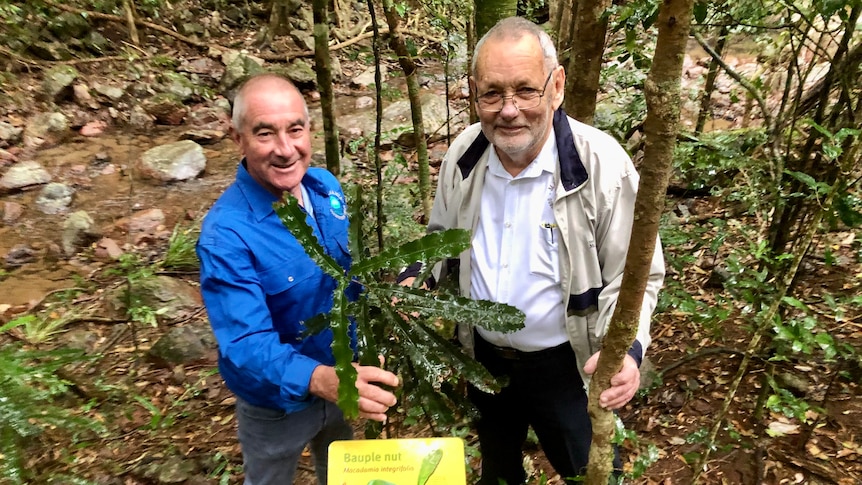Ian McConachie is eager to find the answer to an ancient mystery — just how many hundreds of years do Australia’s wild macadamias live?
Key points:
- A new Walk with Wild Macadamias trail has been opened
- Wild macadamia trees are threatened species
- Conservationists are creating awareness about the value of their rare genetics
Aboriginal and Torres Strait Islander readers are advised that this article contains images and names of people who have died.
After decades of visiting a precious remnant of the threatened species’ habitat in Queensland’s Amamoor State Forest, the founder of the Macadamia Conservation Trust has already discovered that looks can be deceiving.
“So many people are familiar with the macadamia but to see it in the rainforests is just quite mind-boggling,” Mr McConachie AM said.
“It’s nothing like you would expect, they hide amongst all the other trees.”
Living time capsules
A self-described “macadamia dinosaur”, retired food scientist, field researcher, grower and passionate historian, Mr McConachie singled out a spindly chest-high tree, as a perfect example of how even a small plant could potentially be hundreds of years old.
“It’s only got about 18 leaves. I first saw it 1979 and between 1979 and now, it has not grown at all. It’s sitting in the rainforest in dense shade, just waiting until it receives light,” he said.
The oldest European-planted macadamia tree has been growing in Brisbane’s Botanic gardens since 1858 and still bears a healthy crop of nuts.
“One of the initiatives we’re taking is we’re starting to do radiocarbon dating of trees in the rainforest so we can see just what their longevity is and how old they might be,” Mr McConachie said.
Three years ago scientists made the “shocking” DNA discovery that the global macadamia industry emanated from a single tree, or small stand of trees, at Mooloo.
“There is possibly 100 million macadamia trees grown throughout the world that have all originated from one mother tree that is very close to here,” Mr McConachie marveled.
Treasured and traded by Australia’s First Nations people, the macadamia is our country’s only plant to become an international food.
Nuts were taken to Hawaii in 1881, where the crop was first commercialized.
Macadamia Trust director Andy Burnside has estimated that clearing, urban encroachment, fire and weeds have destroyed as much as 90 per cent of the wild population.
All four of its species have been listed as threatened. With permission, cuttings have been taken from wild trees.
“The genetic base of our commercial industry is quite narrow,” Mr Burnside said.
“What we’re trying to do is conserve some genetic material from wild stands of trees and cultivate some trees in a safe environment in several arboreta in various locations in eastern Australia.”
Pest and disease resistance, size and climate adaptability are just some of the traits these wild trees could provide to safeguard the world’s genetically vulnerable commercial crop.
cracking business
The Australian Macadamia Society has estimated the global macadamia farmgate value would be worth $1.63 billion this year.
“We have sampled over 600 wild macadamia trees and studied their DNA markers,” Mr McConachie said.
“We are just realizing just how enormously diverse the genetics are and that is terribly important in the future.”
A new Walk with the Wild Macadamias trail, including interpretive signage, has opened opposite the Amama Day Area in the Amamoor State Forest — off the road that Australia’s country music fans drive on their annual pilgrimage to Gympie’s Music Muster.
Traditional owner Russell Bennet, hopes that ecotourists will be hungry to learn more about the tasty nut and its habitat.
“I’m born and bred in Gympie. I’m Gubbi Gubbi, Wakka Wakka, Kullilli. This is my country. I’ve been a custodian all my life and looked after this country,” he said.
“I really hope that we can highlight the importance of these macadamias out here so we can preserve them and thus preserve the bush they live in.”
.
